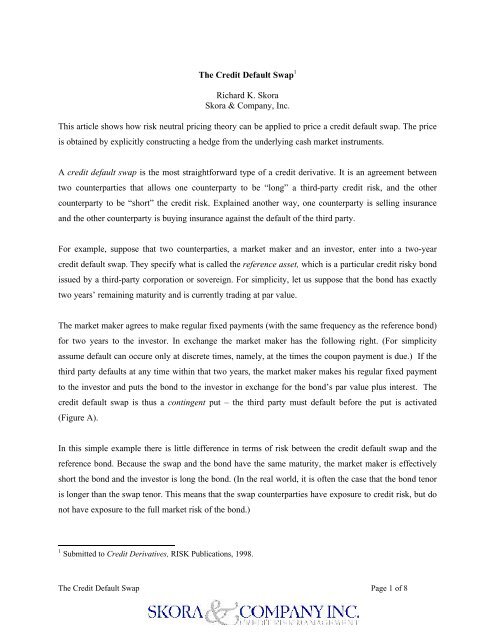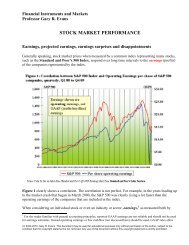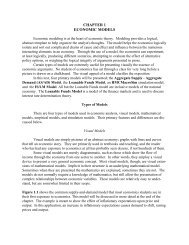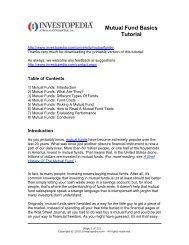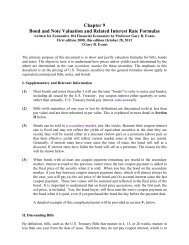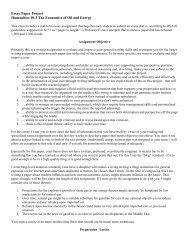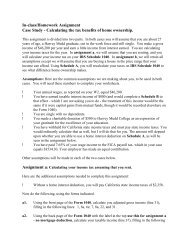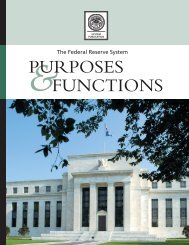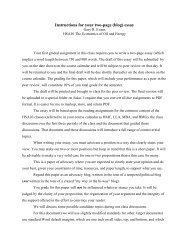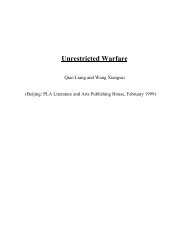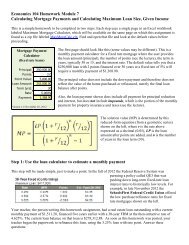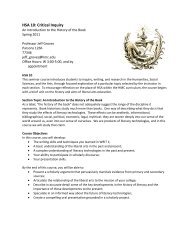The Credit Default Swap
The Credit Default Swap
The Credit Default Swap
You also want an ePaper? Increase the reach of your titles
YUMPU automatically turns print PDFs into web optimized ePapers that Google loves.
<strong>The</strong> investor then sells the bond in the debt markets and must pay Libor + X basis points to the bondbuyer. <strong>The</strong> hedge is costing the investor a net cashflow of X + Y basis points. This perfectly hedges theinvestor’s risk in the credit default swap. 2Notice that the hedges are not symmetric. <strong>The</strong> market maker is receiving X basis points from his hedgewhile the investor is paying X + Y basis points from his hedge. So the hedges determine the price of thecredit default swap up to a range. <strong>The</strong> market is left with a spread of approximately Y basis points whichcannot be arbitraged away.Exactly where the price of the credit swap falls in the range of X to X + Y depends on the counterpartiesand their motivations. Counterparties to credit default swaps are entering into a customised, off-balancesheet transaction that has certain intangible advantages over the cash markets. Market-makers orcommercial bank lenders looking for credit protection on a certain name might be willing to pay as muchas X + Y or more. On the other hand an investor looking for some extra premium may be willing to acceptas little as X or less. Market makers with sub-Libor funding rates, and investors with above-Libor fundingrates, would find the credit default swap even more favourable.In general, pricing credit default swaps is not this simple. We mentioned above that the bond tenor maywell be longer than the swap tenor, but it is also often the case that the bond is not trading at par, or thatcoupon payments are fixed instead of floating. <strong>The</strong> price also depends on the particular terms of the swapagreement and the reference security.Despite the simplicity, the exercise demonstrates several things. Firstly, risk neutral pricing theory bothworks and does not work in the credit markets. It gives a good bound for the price of the credit defaultswap, but it does not give a single price because the assumptions of risk–neutral pricing (marketcompleteness, liquidity and lack of transaction costs) do not apply. Note that the market uses risk neutralpricing (with care) to price credit default swaps and other credit derivatives. In particular, pricing modelsare calibrated to the bond market, as opposed to calibrating to the historical price of credit. Sometimeslooking at historical default rates and recovery rates serves as a good check of the final price.2 Actually this is not a perfect hedge. <strong>The</strong> investor has taken on a very small amount of additional credit risk to theRepo markets.<strong>The</strong> <strong>Credit</strong> <strong>Default</strong> <strong>Swap</strong> Page 3 of 8
Secondly, the credit default swap is somewhere in-between a cash instrument and a derivative product.<strong>The</strong> more complicated credit default swaps may not be perfectly replicated in the cash markets, but thecash markets give some guidance to the correct price of default swaps.<strong>The</strong> credit default swap market will follow the interest rate swap market. While the credit default swapmarket will never be as deep nor as liquid as the interest rate swap market, the bid/ask spreads willdecrease and the credit default swap will function like its own primary market Thus the default swapcurve should serve as the starting point to pricing all other credit derivative models, just as the interestrate swap curve is the input into pricing all other interest rate derivatives.<strong>The</strong> <strong>Credit</strong> <strong>Default</strong> <strong>Swap</strong> Page 4 of 8
CounterpartyAFixed PaymentCounterpartyB- - - - - - - - - - - - - - - - - - - - - -CounterpartyABond + fixed paymentPar Value of Bond +InterestCounterpartyB<strong>Default</strong>- - - - - - - - - - - - - - - - - - - - - -CounterpartyACounterpartyBNo <strong>Default</strong>- - - - - - - - - - - - - - - - - - - - - -<strong>Credit</strong> <strong>Default</strong> <strong>Swap</strong><strong>The</strong> <strong>Credit</strong> <strong>Default</strong> <strong>Swap</strong> Page 5 of 8
Figure ADebtMarketLibor + XCounterpartyALiborFundingMarketMarket Maker’s HedgeFigure B<strong>The</strong> <strong>Credit</strong> <strong>Default</strong> <strong>Swap</strong> Page 6 of 8
CounterpartyBLibor + XDebtMarketLibor – YRepoMarketInvestor’s HedgeFigure C<strong>The</strong> <strong>Credit</strong> <strong>Default</strong> <strong>Swap</strong> Page 7 of 8
Skora & Company Inc. is a new credit risk management advisory firm which offers numerous products and servicesto successfully manage, trade, sell, model and structure credit risk. It has the expertise and experience to support itsclients at every stage of their business development.Skora & Company has already helped financial and non-financial institutions set up profitable credit derivativestrading desks, build cutting edge portfolio credit risk management systems, and design efficient credit risk/returnperformance analytics.Richard K. Skora is the founder of Skora & Company. He worked in the credit risk management since 1992. Healso traded various exotic credit derivatives including default swaps, default options, and basket swaps.Mr. Skora received a B.S. in mathematics from <strong>The</strong> University of Illinois in Champaign-Urbana and a Ph.D. inmathematics from <strong>The</strong> University of Texas in Austin. He held academic positions at <strong>The</strong> Institute for AdvancedStudy in Princeton and Columbia University in New York.26 Broadway, Suite 400 ♦ New York, New York 10004212-785-3518 Fax: 212-785-3519www.skora.com<strong>The</strong> <strong>Credit</strong> <strong>Default</strong> <strong>Swap</strong> Page 8 of 8


